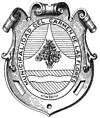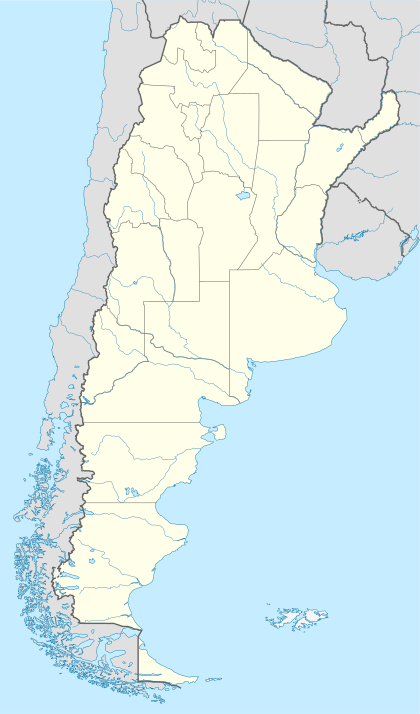Las Flores, Buenos Aires
Las Flores is a city in the province of Buenos Aires, Argentina, and the only city in Las Flores Partido. It had a population of about 24,000 at the 2010 census [INDEC]. It is located 187 km from Buenos Aires City. The main economic activities in the area are agriculture and cattle breeding.
Las Flores | |
|---|---|
City | |
 Flag  Seal | |
 Las Flores Location in Argentina | |
| Coordinates: 36°0′50″S 59°06′00″W | |
| Country | |
| Province | |
| Partido | |
| Founded | May 25, 1856 |
| Elevation | 36 m (118 ft) |
| Population | |
| • Total | 23,871 |
| CPA Base | B 7200 |
| Area code(s) | +54 2244 |
It is served by Las Flores Airport, a rural airport 4 kilometres (2 mi) south of the city.
Las Flores sign
Climate
| Climate data for Las Flores, Buenos Aires Province (1961–1990, extremes 1961–present) | |||||||||||||
|---|---|---|---|---|---|---|---|---|---|---|---|---|---|
| Month | Jan | Feb | Mar | Apr | May | Jun | Jul | Aug | Sep | Oct | Nov | Dec | Year |
| Record high °C (°F) | 39.5 (103.1) |
37.6 (99.7) |
38.0 (100.4) |
33.5 (92.3) |
31.0 (87.8) |
26.0 (78.8) |
29.0 (84.2) |
32.5 (90.5) |
33.0 (91.4) |
32.5 (90.5) |
36.4 (97.5) |
39.8 (103.6) |
39.8 (103.6) |
| Average high °C (°F) | 30.6 (87.1) |
29.6 (85.3) |
25.6 (78.1) |
21.3 (70.3) |
17.5 (63.5) |
14.2 (57.6) |
14.0 (57.2) |
15.3 (59.5) |
18.1 (64.6) |
21.4 (70.5) |
25.4 (77.7) |
28.5 (83.3) |
21.8 (71.2) |
| Daily mean °C (°F) | 22.8 (73.0) |
21.9 (71.4) |
18.9 (66.0) |
14.8 (58.6) |
11.8 (53.2) |
9.1 (48.4) |
9.1 (48.4) |
9.7 (49.5) |
12.2 (54.0) |
15.1 (59.2) |
18.4 (65.1) |
20.9 (69.6) |
15.4 (59.7) |
| Average low °C (°F) | 15.0 (59.0) |
14.2 (57.6) |
12.2 (54.0) |
8.3 (46.9) |
6.1 (43.0) |
4.0 (39.2) |
4.2 (39.6) |
4.1 (39.4) |
6.3 (43.3) |
8.8 (47.8) |
11.4 (52.5) |
13.3 (55.9) |
9.0 (48.2) |
| Record low °C (°F) | 3.2 (37.8) |
1.2 (34.2) |
0.5 (32.9) |
−4.7 (23.5) |
−7.6 (18.3) |
−9.0 (15.8) |
−9.3 (15.3) |
−6.5 (20.3) |
−6.0 (21.2) |
−5.5 (22.1) |
−3.9 (25.0) |
0.0 (32.0) |
−9.3 (15.3) |
| Average precipitation mm (inches) | 98 (3.9) |
92 (3.6) |
96 (3.8) |
94 (3.7) |
59 (2.3) |
48 (1.9) |
50 (2.0) |
52 (2.0) |
61 (2.4) |
101 (4.0) |
100 (3.9) |
98 (3.9) |
949 (37.4) |
| Average precipitation days (≥ 0.1 mm) | 9 | 7 | 8 | 7 | 7 | 7 | 7 | 6 | 6 | 10 | 9 | 8 | 91 |
| Average relative humidity (%) | 68 | 73 | 78 | 79 | 83 | 82 | 83 | 79 | 74 | 74 | 67 | 66 | 76 |
| Source 1: Food and Agriculture Organization[1] | |||||||||||||
| Source 2: Servicio Meteorológico Nacional (humidity, 1981–1990 precipitation days 1961–1990, and extremes)[2][3][4] | |||||||||||||
gollark: I think the fear is that it will spur lots of research without much regard for safety.
gollark: I think it's just expressions to integrate, not mathematical proofs or whatever with language in them.
gollark: My friend just sent me this. It sounds interesting. Thoughts? https://arxiv.org/abs/2110.03501
gollark: Surely you could shorten `plt`, remove some spaces, and swap out the `itertools` line (as it only appears to be using accumulate once).
gollark: On their latest process, even.
References
- "FAOClim-NET: Agroclimatic database management system". Food and Agriculture Organization. Archived from the original on 2016-08-01. Retrieved July 29, 2016.
- "Datos Estadísticos (Período 1981–1990)" (in Spanish). Servicio Meteorológico Nacional. Retrieved July 2, 2015.
- "Valores Medios de Temperature y Precipitación-Buenos Aires: Las Flores" (in Spanish). Servicio Meteorológico Nacional. Retrieved July 29, 2016.
- "Clima en la Argentina: Guia Climática por Las Flores Aero". Caracterización: Estadísticas de largo plazo (in Spanish). Servicio Meteorológico Nacional. Archived from the original on 4 September 2017. Retrieved 7 October 2017.
- Municipality of Las Flores - Official website.
- Municipal information: Municipal Affairs Federal Institute (IFAM), Municipal Affairs Secretariat, Ministry of Interior, Argentina. (in Spanish)
This article is issued from Wikipedia. The text is licensed under Creative Commons - Attribution - Sharealike. Additional terms may apply for the media files.